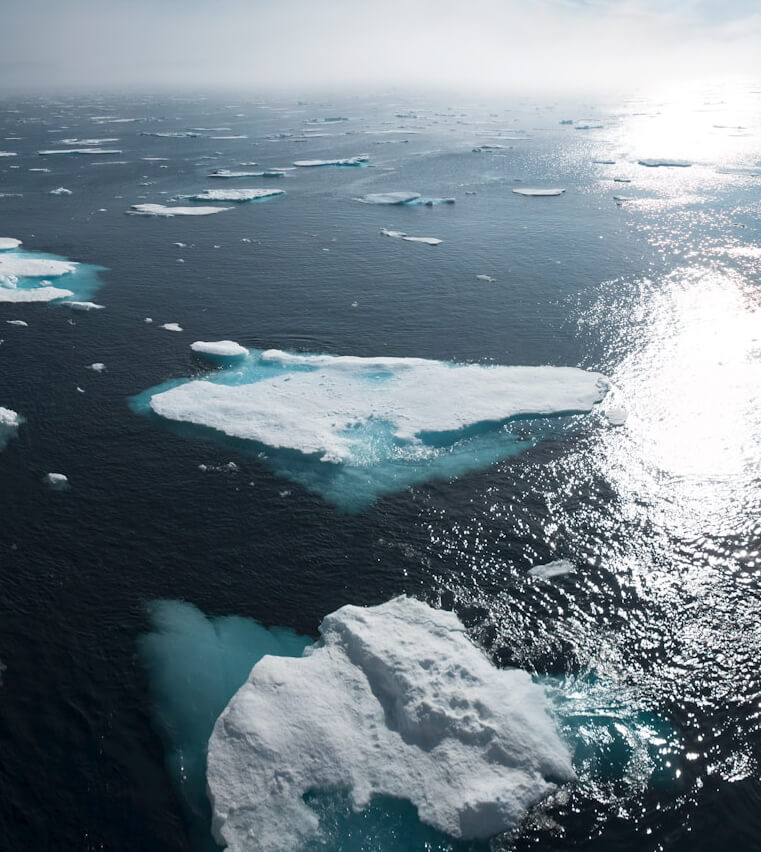How can it bedefined?
Geoengineering refers to deliberate large-scale interventions in the Earth's climate system to mitigate or counteract the effects of climate change. There are many forms of geoengineering based on different techniques and technologies.
These can broadly be split into 2 groups:
01
Carbon dioxide removal techniques
Focus on (direct air) capture and storage of carbon dioxide.
02
Solar radiation management (SRM) techniques
Focus on reflecting a portion of the incoming sunlight back into space to reduce the warming effects of greenhouse gases.
Marine Cloud Brightening
As an SRM technique, Marine Cloud Brightening strives to achieve this effect by increasing the reflectivity of marine clouds and is therefore a (very mild) form of geoengineering.
Why is MCBso promising?
We have massively changed the composition of our atmosphere by burning fossil fuels. This is causing catastrophic climate change. There is the question of whether it is wise to try to undo one form of human manipulation of the climate with yet another form of human intervention (for example: SRM).
The RAF believes that applying the Climate Repair Deal's 3Rs is the only way forward.
the Climate Repair Deal's 3Rs are:
Reduce
...GHG emissions
Remove
...GHGs from the atmosphere
Refreeze
...the Arctic
For Refreeze, RAF advocates Marine cloud brightening
Neither peak oil nor peak gas have yet been reached (peak = moment of maximum production). Even
global coal production is enjoying a revival. Significant Reduction will therefore not happen soon.
Unfortunately, Removal at scale is not living up to its promise either. The yearly CAT (Carbon
Action Tracker) Thermometer and CAT Emissions GAP show the desperate state of our Reduction and
Removal pledges: climateactiontracker.org.
Meanwhile, based on our past and still increasing GHG emissions, we are trespassing tipping points.
Once we cross these tipping points, global warming accelerates uncontrollably and becomes
irreversible even if, by some magic, we would suddenly decide to drastically Reduce and Remove.
Tipping points are the scariest aspect of global warming.
MCB can cool down the planet temporarily – up to 1C - keeping all tipping points at bay, refreezing
the Arctic, relieving coral heat stress, deenergizing hurricanes, and crucially, giving us a brief
respite to cut our addiction to fossil fuels once and for all.
If MCB research is properly funded, MCB could be deployed by the end of the decade, and at low cost.
Assessing thesafety of mcb
The RAF argues that MCB is more like a gentle form of cloud engineering, making marine clouds brighter in places where their increased albedo produces the most cooling.
MCB mimics nature by using sea water spray and natural convection to carry sea salt crystals into marine clouds. There, the sea salt crystals act as cloud condensation nuclei (CCNs), creating myriads of tiny cloud droplets. These tiny cloud droplets brighten marine clouds. MCB is based on well-understood cloud physics and marine ecology, it can be applied locally, and if collateral damage does seem to occur despite all the precautions taken, MCB can be switched off at once. Within days, the cloud brightening stops.
The RAF argues that further research into sea water sprays, marine cloud dynamics and MCB side-effects (does MCB influence rain patterns? Locally? Globally?) is urgently, perhaps even desperately, needed.


What are the ethical concerns?
1. Some scientists want to ban research into SRM
The RAF asks:
What happens if our planet keeps heating up and that heating cannot be reversed? What happens if we breach tipping points? Research in all forms of planetary cooling must continue, if only to understand their potential side effects.
2. There is a moral hazard argument which suggests SRM research will encourage more greenhouse gas emissions or in any case make “reduce” and “remove” less urgent.
The RAF argues:
Research breakthroughs in other fields have not led to reckless behaviour: safety belts have not made drivers more reckless and lung cancer research has not encouraged more smoking. Perhaps most pertinent to this discussion: fire insurance has not led to increased arson! At a minimum, research into all SRM techniques should be viewed as an insurance policy, just in case.


Comparing other srmtechniques to mcb
Various solar radiation management (SRM) techniques are being researched.
We at the RAF organised a beauty contest comparing the most prominent SRM techniques. As expected, MCB comes out as the Beauty Queen, by a large margin.
Choose a technique below:
MCB offersUnique advantages
MCB’s most important features stand in stark contrast to the drawbacks of other SMR techniques:
MCB brightens specific marine clouds, providing cooling for heat-stressed ecosystems underneath (eg. Great Barrier Reef) whilst at the same time cooling the planet. Any unintended side effects, if they arise, remain localized and manageable.
MCB occurs only when spraying is active and lasts for the duration of marine clouds (a couple of days). Consequently, MCB’s effects cease shortly after spraying stops, ensuring full reversibility. Any unintended side effects, if they arise, dissipate within days of discontinuing the spraying.
MCB does not need any mechanical devices to lift sea salt CCNs into low lying marine clouds, elegantly solving the “aerosol delivery” challenge.
MCB uses sea salt crystals as CCNs and therefore does not introduce any anthropogenic chemicals into marine clouds. Furthermore, the amount of sea salt needed to achieve MCB is negligible compared to what is naturally dispersed during phenomena like gales, tempests, and hurricanes.
MCB simulates well-understood natural processes, drawing from extensive scientific research on marine cloud dynamics and ecosystems. MCB research should therefore rapidly yield results, allowing deployment within a decade.
MCB could be deployed just in time to refreeze the Arctic, mitigate the worst impacts of climate change, and temporarily keep tipping points at bay. Its cost, for deployment and maintenance, is significantly lower than the yearly damage caused by climate change today – let alone tomorrow. As a low-cost technique, MCB emerges as our most effective means to adapt to global warming.